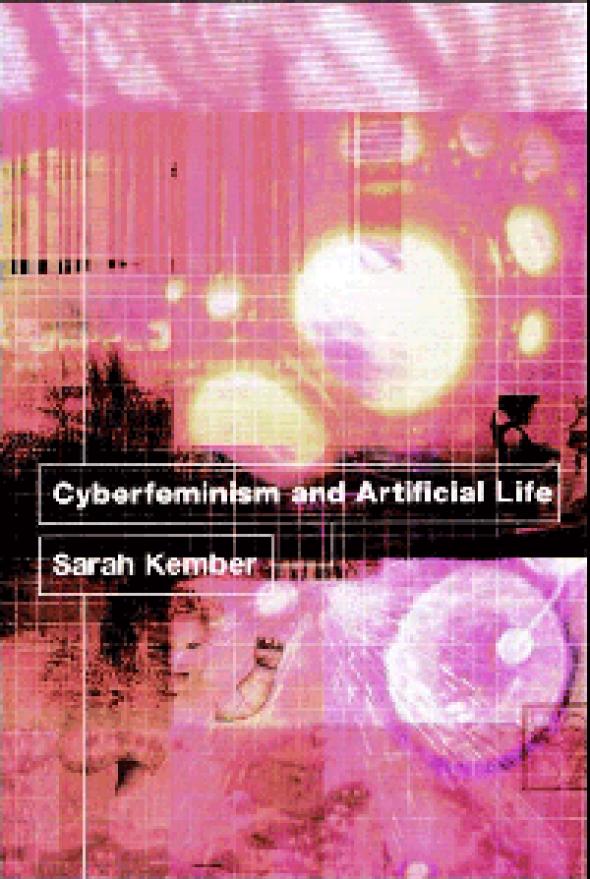Get Alive
Nat Muller reviews Sarah Kember's cyberfeminist book
The title of Sarah Kember’s Cyberfeminism and Artificial Life is misleading: the conjunction of cyberfeminism with artificial life (AL) suggests both components might receive an equal amount of attention, which is not the case. If the objective is – as Kember outlines in the preface – ‘to trace the development of identities and entities within the global information network encompassing both human and non-human environments, and to offer a pluralised cyberfeminist engagement with artificial life as both a discipline and cultural discourse,’ then the feminist – or gender critical project – is hard to find.
Instead, the first few chapters meticulously position discourses of AL within a historical and scientific framework. In dense and eloquent prose Kember deconstructs the reductionist discourse of Darwinian biology, wherein nowadays the gene plays the starring role. She traces molecular biology’s obsession with the gene as the magic tell-all code of life back to the language of information theory, i.e. cold war cybernetics, wherein information functions solely as form (message), not content (matter). It is in this arena that evolutionary biology’s infamous ‘chicken (matter, body) and egg (gene, form)’ question is debated: can the essence of life be understood by eradicating the body and reducing it to strands of genetic code? How does this affect concepts of artificial life, and what are its ethical implications? Kember is particularly sharp when attacking Richard Dawkins – who is admittedly an easy target – yet it is always very enjoyable to see Dawkins being smashed up intelligently and relentlessly. Dawkins becomes the vehicle by which to turn the discussion to socio-biology, and take stock of another zone of the life sciences where biological determinism and constructivism figure as opponents, namely the nature-versus-culture debate. Although Kember here makes use of very well-known examples, which cultural studies has regurgitated ad nauseam, she does manage to give an interesting and well-documented overview of AL’s and evolutionary biology’s most pressing issues.
Halfway through the book, which is very well-referenced and interlaced with an abundance of quotations, still no mention has been made of how, or more importantly WHY, Kember wants to view the contradictory discourses of AL through a feminist lens. Moreover, no mention of feminism or feminists has been made at all! As careful as the author is to document and position herself in relation to various theories of (evolutionary) biology, she neglects to contextualise or position herself in relation to (cyber)feminism, and what the latter might entail. All is somehow taken for granted. After the fourth chapter, Kember starts losing her argument completely, and jumps from descriptions of commercial and educational AL games, such as SimCity, Tierra, Creatures, etc., to intelligent agents, bots, robotics, and on to artists working with AL. It is as if she were sharing the preliminary research she has compiled with us, but has not yet made up her mind how she actually wants to structure it: what exactly she wants to criticise, and how.
Only in the last chapter ‘Evolving Feminism in Alife Environments’ – which in its first paragraphs reads as an apologetic defence of the book – does Kember come back to her gender critical project and finally clarifies what cyberfeminism means to her. However, her characterisation of cyberfeminism is problematic, as is her reluctance to clearly name and historically situate the feminist theorists she quotes (Rosi Braidotti, Alison Adams, Donna Haraway, Sandra Harding, Elisabeth Wilson) as important proponents of feminist standpoint epistemology and other currents of feminist science criticism.
Kember does finally manage to articulate her thesis, namely that feminism has to undertake risks in order to spur a constructive dialogue with the life sciences. This entails an urgent reconceptualisation of feminism’s ‘naturalised’ anti-essentialism and anti-biologism, and hence steps beyond the nature-versus-culture debate. This final chapter seems like an emergency manoeuvre, Kember’s attempt to make up for she did not deliver in the book as a whole. It is a pity that the last chapter wasn’t the first, and that the rest of the book wasn’t developed accordingly.
Cyberfeminism and Artificial Life // Sarah Kember // London: Routledge // 2003 // ISBN 0-415-24027-1 // 257 pages // £13.99 & $22.95
Mute Books Orders
For Mute Books distribution contact Anagram Books
contact@anagrambooks.com
For online purchases visit anagrambooks.com








